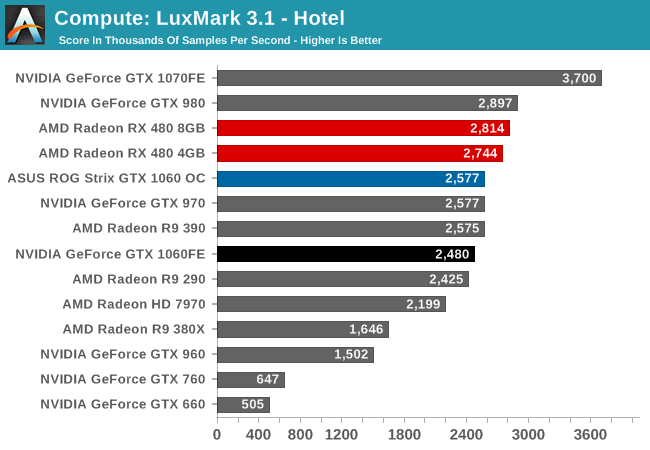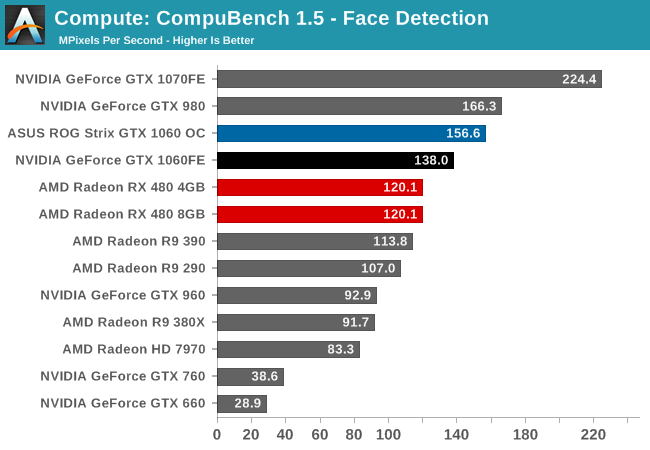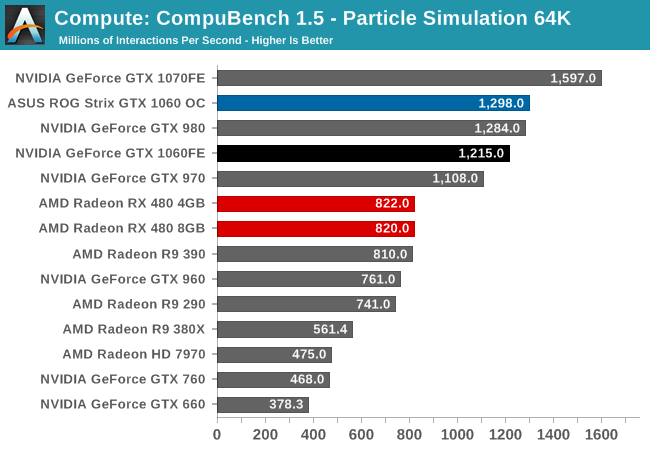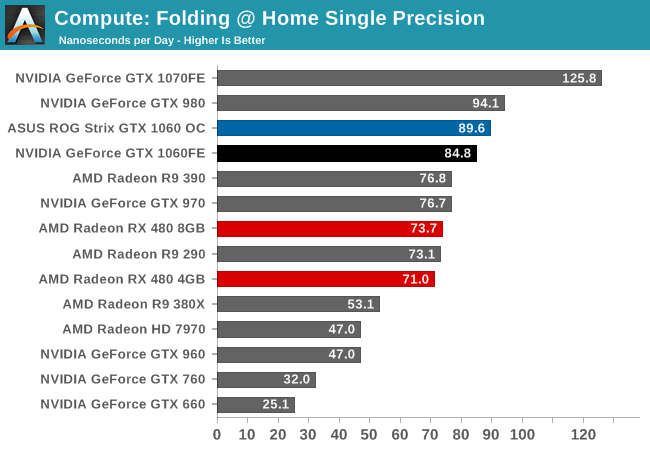The GeForce GTX 1060 Founders Edition & ASUS Strix GTX 1060 Review
by Ryan Smith on August 5, 2016 2:00 PM ESTCompute
Shifting gears, let’s take a look at compute performance on GTX 1060.
As we already had the chance to categorize the Pascal architecture’s compute performance in our GTX 1080 review, there shouldn’t be any surprises here. But it will be interesting to see whether the GTX 1060’s higher ratio of memory bandwidth per FLOP materially impacts overall compute performance.
Starting us off for our look at compute is LuxMark3.1, the latest version of the official benchmark of LuxRender. LuxRender’s GPU-accelerated rendering mode is an OpenCL based ray tracer that forms a part of the larger LuxRender suite. Ray tracing has become a stronghold for GPUs in recent years as ray tracing maps well to GPU pipelines, allowing artists to render scenes much more quickly than with CPUs alone.

While GTX 1060 could hang with GTX 980 in gaming benchmarks, we don’t start off the same way with compute benchmarks, with the last-generation flagship holding about 17% ahead. Unfortunately for NVIDIA, this is about where GTX 1060 needed to be to best RX 480; instead it ends up trailing the AMD competition. Otherwise the performance gain versus the GTX 960 stands at 65%.
For our second set of compute benchmarks we have CompuBench 1.5, the successor to CLBenchmark. CompuBench offers a wide array of different practical compute workloads, and we’ve decided to focus on face detection, optical flow modeling, and particle simulations.



Like with GTX 1080, relative performance is all over the place. GTX 1060 wins with face detection, loses at optical flow, and wins again at particle simulation. Even the gains versus GTX 960 are a bit more uneven, though at the end of the day GTX 1060 ends up being significantly faster than its predecessor with all 3 sub-benchmarks.
Moving on, our 3rd compute benchmark is the next generation release of FAHBench, the official Folding @ Home benchmark. Folding @ Home is the popular Stanford-backed research and distributed computing initiative that has work distributed to millions of volunteer computers over the internet, each of which is responsible for a tiny slice of a protein folding simulation. FAHBench can test both single precision and double precision floating point performance, with single precision being the most useful metric for most consumer cards due to their low double precision performance. Each precision has two modes, explicit and implicit, the difference being whether water atoms are included in the simulation, which adds quite a bit of work and overhead. This is another OpenCL test, utilizing the OpenCL path for FAHCore 21.


Finally, in Folding@Home, we see the usual split between single precision and double precision performance. GTX 1060 is solidly in the lead when using FP32, but NVIDIA’s poor FP64 rate means that if double precision is needed, RX 480 will pull ahead.










189 Comments
View All Comments
thkg - Friday, August 5, 2016 - link
Well the price landscape is not all accurate.The cheapest 1060 you can buy right now cost $299 (the FE model).
You right now can buy a RX 480 8G from newegg for $239 (http://www.newegg.com/Product/Product.aspx?Item=N8...
Ryan Smith - Friday, August 5, 2016 - link
The pricing situation is complex at best, and frustrating at worst. At various times when I wrote this article $249 GTX 1060s and $239 RX 480s went in and out of stock. At the moment it was published, all 480s were out of stock and $249 and $279 1060s were in stock.The article is written with the best general advice I can give, which is based on the idea that manufacturers are frequently restocking the MSRP parts. But since things fly off the shelves so quickly, there's no real consistency day to day. (Or even hour to hour; that 480 is out of stock already). Ultimately you can get a $249 1060 about as easily as you can get a $239 480, which is to say not very (and it's not as if higher priced cards are usually any more available).
eddman - Saturday, August 6, 2016 - link
Really?!! Do you know what shortage is? I clicked on that link and it said... not available.There ARE 1060s at $250 already. They are just hard to get.
http://www.newegg.com/Product/Product.aspx?Item=N8...
http://www.newegg.com/Product/Product.aspx?Item=N8...
http://www.newegg.com/Product/Product.aspx?Item=N8...
eddman - Saturday, August 6, 2016 - link
Wrong link for the second one. This is it:http://www.newegg.com/Product/Product.aspx?Item=N8...
eddman - Saturday, August 6, 2016 - link
It seems my brain isn't cooperating. Those links are correct. This is the additional link:http://www.newegg.com/Product/Product.aspx?Item=N8...
Fnnoobee - Friday, August 5, 2016 - link
Really, Anandtech? Date of this review is Aug. 15 and yet you're using Nvidia's latest driver but AMD Crimson 16.7.1? Really?! I could see if you published this around July 19 (you know, when the card actually hit shelves), but 16.7.2, which fixed the power draw and thermal issues on RX 480 and increased performance overall across the board, released July 7, almost a month ago! 16.7.3 released July 29, which other than providing bug fixes added a significant 10 percent performance boost for RoTR which you benchmarked. I could see if you were ignorant of these releases but you even published an article on your site on July 29. I knew right away before even looking at the details of your test set up when I saw your benchmarks on RoTR, because they're far lower than numbers I've consistently achieved on the benchmark at the same settings you have on my RX 480 at stock clocks (OC I achieved about 6-7 percent more). If you can't be bothered to properly update your tests to the latest drivers and software for both product lines so ALL products get a fair shake, why even bother reviewing or comparing a product in the first place? It smacks of laziness and not being very fair and objective.Ryan Smith - Friday, August 5, 2016 - link
Thanks. 16.7.1 is actually a typo. All testing was done against 16.7.2 for the RX 480.As for 16.7.3, this came out much too late to be included in this review (since it takes longer than a week to produce). However I will need to go back and update the RX 480 results for that driver build for the forthcoming 470/460 reviews.
bill44 - Friday, August 5, 2016 - link
Before I read it, does it mention audio and supported audio sampling rates?@Ryan Smith
I know.........not at hand.......blah, blah.
No one knows, it's not on the spec sheet, not in reviews, nowhere to be found.
Ryan Smith - Friday, August 5, 2016 - link
I don't have that information or a means to test it. But was there a specific sampling rate you're looking for?bill44 - Saturday, August 6, 2016 - link
Thank Ryan.Yes please, 88.2KHz and 176.4KHz. Likelihood is that the other sampling rates will be supported.